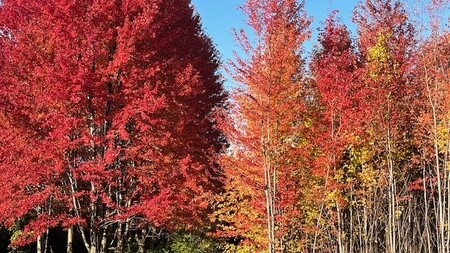By Kane County Recycling Coordinator Clair Ryan via Kanecountyconnects.com
Most people come to the Kane County Recycling webpages looking for information about how to get rid of things. In the case of fall leaves, residents with yards should consider keeping some or all of their leaves as a resource.
Leaves are a free, carbon rich fertilizer for lawns and planting beds. They also provide critical overwintering habitat for a variety of native insects and amphibians, which are important players in the natural food web. With more and more development in Kane County, our native wildlife really counts on backyard habitat to get by.
Leaving leaves does not have to be “all or nothing.” The actions suggested below can be combined with each other and combined with traditional leaf pick-up programs (see a list of 2023 programs here). Even just a portion of leaves left in-place can make a big difference.
- Know your leaves. Leaves from some species of trees and shrubs (box elder, for example) dry out and disintegrate very quickly. These leaves are ideal to rake or mulch into lawns to decompose naturally. On the other end of the spectrum, some species’ leaves (oaks, for example) take a relatively long time to decompose. A thick blanket of oak leaves left on the lawn will likely smother the turf. Most species leaves are somewhere in between these two extremes. Homeowners can develop a more informed leaf management strategy by taking some notes on species types, leaf quantities, and timing of when different trees lose their leaves. The silver maple on my neighbor’s parkway always pulls a “gotcha” every year by dumping its leaves in mid-December, after the vacuum truck program in my town is done, which requires some extra planning.
- Blanket your beds. Any type of planting bed, including tree root zones or mulch circles, are great places to leave some leaves. A three-to-five inch blanket of whole leaves can help insulate perennial plant and tree roots in the event of a particularly harsh winter. You can cover the leaves up with wood mulch in the spring, if desired. Over time, the leaves will add organic matter to the soil and improve the soil’s ability to retain water, making your garden more drought resistant.
- Mulch ‘n’ mow. Most lawnmowers will make short work of a thin layer of leaves, shredding them up into mulch. Just make sure to run the mower without the collection bag to ensure that the mulched leaves and last grass clippings of the year are returned to the soil as a slow-release fertilizer. Mowers might not cope as well with wet or very thick leaves, so timing is important for this approach.
- Create a winter leaf pile. This involves finding an out-of-the-way and semi-sheltered spot in the yard to create a temporary leaf pile. The size and height of such a pile should be planned so as not to be a nuisance to neighbors or to run afoul of local ordinances or HOA rules. Simply let the leaves sit for the winter and clean them up/send them for composting in the spring, by which time the critters that need leaves for overwinter habitat will have moved on.
- Compost at home. Whole or shredded leaves make great “brown” material for any home compost set up. Learn more here!








